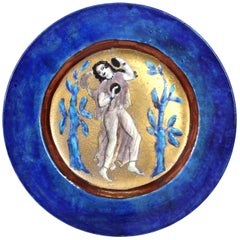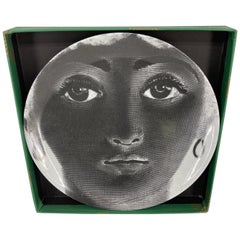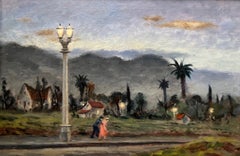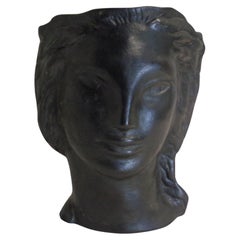Edith Varian Cockcroft Art
American, 1881-1962
A painter in the modernist styles of her era, Edith Cockcroft was heavily influenced by Henri Matisse with whom she studied in Paris in 1898. She was born in Brooklyn to wealthy parents and lived in Allendale, New Jersey.
In 1898, she went to France where she spent much time in the art colonies of Pont Aven and Concarneau. She exhibited in Paris at the Salon de la Society Nationale des Beaux Arts and the Salon d'Automme. "There is probably no truth to the often repeated story that she was a mistress to Paul Gaughin for, by 1898, he had traveled to the South Seas for the last time."
During the early part of the 20th Century, she traveled to England, judging by the fact that her 1908 entry in the National Academy of Design was a scene of St. Ives. She also exhibited at the Academy from 1910 to 1915, and at the Art Institute of Chicago, the International Art Union, the Salons of America, the Pennsylvania Academy and the Corcoran Gallery.
She married as a teen ager and lived with her husband in New York City and then in Sloatsburg, New York. Her husband, Charles Weyand, was a stock broker who lost much money during the Depression, so she supported them with the making of pottery, jewelry and with fabric designs.
In her later years, she traveled to Haiti and did many Haitian paintings. She died in Ramapo, New York. A fire in her studio had destroyed a large number of her paintings, and in the 1990s, a large number of her works were found, having been rescued from a trash compactor.(Biography provided by Lincoln Glenn)
to
2
2
2
1
1
Edith Varian Cockcroft Art Deco Ceramic Charger Plate with Exotic Dancer
By Edith Varian Cockcroft
Located in New York, NY
American Art Deco glazed ceramic charger plate in Persian blue and gold, made by Edith Varian Cockcroft (American 1881-1962). The piece presents a hand-painted and gilt center with ...
Category
1930s American Art Deco Vintage Edith Varian Cockcroft Art
Materials
Ceramic
Girl in a White Dress, Oil Painting on Canvas by Edith Varian Cockcroft
By Edith Varian Cockcroft
Located in Long Island City, NY
Artist: Edith Varian Cockroft, American (1881 - 1962)
Title: Girl in a White Dress
Year: 1961-1962
Medium: Oil on Canvas, signed l.r.(signed Cocroft)
...
Category
1960s American Modern Edith Varian Cockcroft Art
Materials
Canvas, Oil
Related Items
Piero Fornasetti Tema e Variazioni Porcelain Black and White Large Dish Charger
By Fornasetti
Located in Haddonfield, NJ
The Italian artist and illustrator Piero Fornasetti was one of the wittiest, most imaginative design talents of the 20th Century. He crafted an inimitable decorative style from a personal vocabulary of images that included birds, butterflies, hot-air balloons, architecture and, most frequently, an enigmatic woman’s face. Fornasetti used...
Category
20th Century Italian Mid-Century Modern Edith Varian Cockcroft Art
Materials
Porcelain
Six O'Clock
Located in Los Angeles, CA
Six O-Clock, c. 1942, oil on canvas, 30 x 20 inches, signed and titled several times verso of frame and stretcher (perhaps by another hand), marked “Rehn” several times on frame (for the Frank K. M. Rehn Galleries in New York City, who represented Craig at the time); Exhibited: 1) 18th Biennial Exhibition of Contemporary American Oil Paintings from March 21 to May 2, 1943 at The Corcoran Gallery of Art in Washington, D.C. #87, original price $450 (per catalog) (exhibition label verso), 2) Craig’s one-man show at the Frank K. M. Rehn Galleries, New York City, from October 26 to November 14, 1942, #10 (original price listed as $350); and 3) Exhibition of thirty paintings sponsored by the Harrisburg Art Association at the State Museum of Pennsylvania in Harrisburg in March, 1944 (concerning this exhibit, Penelope Redd of The Evening News (Harrisburg, Pennsylvania) wrote: “Other paintings that have overtones of superrealism inherent in the subjects include Tom Craig’s California nocturne, ‘Six O’Clock,’ two figures moving through the twilight . . . .” March 6, 1944, p. 13); another label verso from The Museum of Art of Toledo (Ohio): original frame: Provenance includes George Stern Gallery, Los Angeles, CA
About the Painting
Long before Chris Burden’s iconic installation outside of the Los Angeles County Museum of Art, Urban Light, another artist, Tom Craig, made Southern California streetlights the subject of one of his early 1940s paintings. Consisting of dozens of recycled streetlights from the 1920s and 1930s forming a classical colonnade at the museum’s entrance, Burden’s Urban Light has become a symbol of Los Angeles. For Burden, the streetlights represent what constitutes an advanced society, something “safe after dark and beautiful to behold.” It seems that Craig is playing on the same theme in Six O-Clock. Although we see two hunched figures trudging along the sidewalk at the end of a long day, the real stars of this painting are the streetlights which brighten the twilight and silhouette another iconic symbol of Los Angeles, the palm trees in the distance. Mountains in the background and the distant view of a suburban neighborhood join the streetlights and palm trees as classic subject matter for a California Scene painting, but Craig gives us a twist by depicting the scene not as a sun-drenched natural expanse. Rather, Craig uses thin layers of oil paint, mimicking the watercolor technique for which he is most famous, to show us the twinkling beauty of manmade light and the safety it affords. Although Southern California is a land of natural wonders, the interventions of humanity are already everywhere in Los Angeles and as one critic noted, the resulting painting has an air of “superrealism.”
About the Artist
Thomas Theodore Craig was a well-known fixture in the Southern California art scene. He was born in Upland California. Craig graduated with a degree in botany from Pomona College and studied painting at Pamona and the Chouinard Art School with Stanton MacDonald-Wright and Barse Miller among others. He became close friends with fellow artist Milford Zornes...
Category
1940s American Modern Edith Varian Cockcroft Art
Materials
Canvas, Oil
Native American Figures at Taos Pueblo, New Mexico Southwestern Oil Painting
Located in Denver, CO
Original 20th century oil painting by Wolfgang Pogzeba (1936-1982) with Native American figures standing in bright blankets with adobe buildings in th...
Category
Mid-20th Century American Modern Edith Varian Cockcroft Art
Materials
Oil, Canvas
H 25.75 in W 29.5 in D 1.75 in
Lips Coupe Plate by Jeff Koons
By Jeff Koons
Located in Jersey City, NJ
To celebrate Bernardaud's 150th anniversary, Jeff Koons made a series of beautiful, limited edition porcelain objects with the famed porcelain maker in Limoges, France. The collectio...
Category
2010s French Edith Varian Cockcroft Art
Materials
Porcelain
Chinese Famille Rose Porcelain Charger, 20th Century
Located in Ottawa, Ontario
A Chinese famille rose
Porcelain charger
20th century.
The center enamelled with two birds
on a flowering peony branch
the rim with further floral cartouches on yellow
scrol...
Category
20th Century Chinese Chinese Export Edith Varian Cockcroft Art
Materials
Porcelain
Gold Mine, Central City, Colorado
By Joseph Meert
Located in Los Angeles, CA
This painting is part of our exhibition America Coast to Coast: Artists of the 1930s
Goldmine, Central City, Colorado, oil on canvas, 36 x 28 inches, c. 1936, signed lower right, ex collection of Platt Fine Art, Chicago, Illinois (label verso).
About the Painting
Joseph Meert’s painting, Goldmine, Central City, Colorado, depicts the short-lived resurrection of a once prominent city just outside Denver. Central City was founded in 1859 soon after John Gregory struck gold in the area. As word spread, thousands of miners converged into “Gregory’s Gulch” and its surroundings became known as the “richest square mile on earth.” Mining production quickly increased resulting in Central City to becoming Colorado’s largest city in the early 1860s. Despite some technical difficulties transitioning to lode mining and the rise of competition from Leadville, Central City remained an economic boom town through the turn of the century. But, with every boom, there is a bust. World War I marked the end of Central City’s prominence as ore production ground to a halt and by 1925, the town’s population shrank to only 400 people. The desperation of the Great Depression and a nearly 100% increase in the price of gold lured labor and capital back to Central City. Meert painted in Colorado during the mid-1930s, a time when he created his most desirable works. It is during this period of renaissance that Meert captures one of Central City's outlying dirt streets bordered by 19th century wooden houses from the town's heyday and the more recently installed electric lines leading to a distant gold mine. A lone figure trudges up the hill, a mother with a baby in her arms, putting us in mind of the rebirth of the town itself. Meert had solo exhibitions at the Colorado Springs Fine Arts Center in 1936 and the Denver Art Museum. Although it is not known whether Goldmine, Central City was included in either of these exhibitions, it seems likely. Moreover, the painting is closely related to Meert’s painting, The Old Road, which was painted in 1936 and exhibited at the Corcoran Gallery of Art in Washington, DC and at the Dallas Museum of Art.
About the Artist
Joseph Meert was a well-regarded painter and muralist, who initially made a name for himself in the American Scene and later as an abstract expressionist. Although initially successful, Meert struggled financially and with mental illness later in life. He was born in Brussels, Belgium, but moved with his family to Kansas City, Missouri. As a child, a chance encounter at the Union Pacific Railyard changed his life. Meert happened upon a worker repainting and stenciling a design on a railroad car. Meert later recalled that this experience introduced him to the idea of being a painter. Without support from his father, Meert obtained a working scholarship to the Kansas City Art Institute. After four years at the Kansas City Art Institute, Meert studied seven years at the Art Students League and in Europe and Los Angeles. At the Art Students League, Meert fell under the spell of Thomas Hart Benton and Stanton MacDonald-Wright. In 1931, he befriended Jackson Pollock. By 1934, Meert was part of the Public Works of Art Project when he met his wife, Margaret Mullin...
Category
1930s American Modern Edith Varian Cockcroft Art
Materials
Oil, Canvas
19th Century Jasperware Cheese Plate
Located in Dublin 8, IE
Heavy Wedgewood cobalt blue Jasperware cheese plate with dome.
The applied white bas relief depicts classical figural scenes with foliate motif against...
Category
Early 19th Century English Neoclassical Antique Edith Varian Cockcroft Art
Materials
Porcelain
Mid Century Sitting Nude Figurative
By Elmer Albritton
Located in Soquel, CA
Mid Century figurative painting of a pensive sitting nude figure with moody, mid-century color palette in the background. Attributed to Elmer S. Albritton, unsigned (American, 1922-...
Category
1960s American Modern Edith Varian Cockcroft Art
Materials
Canvas, Oil, Cardboard
Antique Limoges Hand Painted Scenic Porcelain Charger by D&C, circa 1900
Located in Big Flats, NY
Antique French Limoges charger by D&C offer porcelain construction with landscape scene, maker mark en verso as photographed, circa 1900.
Measures - 1.75"H x 15.5"diam.
Category
Early 20th Century French Edith Varian Cockcroft Art
Materials
Porcelain
Limoges, France, Large Antique Dish in Hand Painted Porcelain with Dancing Women
Located in Copenhagen, DK
Limoges, France. Large antique dish in hand painted porcelain decorated with dancing women and gold edge, early 20th century.
Measures: 33 x 5.5 cm...
Category
Early 20th Century French Edith Varian Cockcroft Art
Materials
Porcelain
The Demogogue
Located in Los Angeles, CA
The Demagogue or Tale in a Tub, 1952, oil on canvas, 20 x 24 inches, signed, titled, and dated verso
About the Painting
The Demagogue is an iconic Bendor Mark painting from the prime of his post-war period. Beginning early in his career, Mark was fascinated with depictions of the human figure and their capacity to tell stories of the world around him. Mark was a keen observer of his times and in The Demagogue we see Mark’s portrayal of a faithless politician holding up a “V” for victory sign as he appeals to the wanton desires and prejudices of the masses. Below the demagogue is a swirl of humanity representing the common man who is being pushed down by the powerful, while the robed figure of liberty with her scales of justice held high is brushed aside. Behind the demagogue, Mark places two other powerful supporting institutions which were often co-opted by the world’s dictators, the Church and the Military. Mark was an internationalist, so it is difficult to know exactly which demagogue inspired him to create this work, but in 1952 there were many to choose from. Whether depicting Argentina’s Peron (the demagogue and the women to the right resemble Juan and Eva Peron), Spain’s Franco or the United States’ homegrown fear mongers like Joseph McCarthy, Mark tells a universal story that unfolded in dramatic fashion during the post-war period as nations and their peoples grappled with authoritarianism and anti-democratic impulses. Stylistically, The Demagogue draws on the elements which make Mark’s work from this period immediately recognizable, a saturated palette, a closely packed and frenetic composition, exaggerated figuration and stylized facial features. But, above all, we see Mark’s ability to tell the stories of the rich and powerful and their ability to oppress. Like Mark’s work in the collection of the Whitney Museum of American Art (The Hourglass - 1950-51) and the Los Angeles County Museum of Art (Execution – 1940), The Demagogue pulls no punches, as the artist lays bare the threats to freedom and basic human rights.
About the Artist
Bendor Mark was an American modernist and social realist painter. Born as Bernard Marcus on June 5, 1912, in Brooklyn, New York, Mark trained at The Cooper Union during the 1920s where he studied with William Brantley van Ingen and became a prize-winning artist with a focus on painting the human figure. After his time at Cooper, Mark continued to live in New York and worked as a commercial artist and textile designer in addition to his pursuit of a career in painting. Like many Depression Era artists, Mark engaged with social progressives and in 1934, he joined the Artist’s Union which had the goal of advancing artists’ position as “worker.” Mark’s painting, Restaurant, which is now in the permanent collection of the Smithsonian American Art Museum, appeared in the February 1936 edition of the Union’s publication, Art Front, as part of a review of an exhibition at ACA Gallery in New York.
Mark worked on the Federal Art Project and by the mid- to late-1930s, began a series of paintings exploring the working conditions and hazards of the mining industry. Mark believed that miners were “in the forefront of the struggle for emancipation” and that the mere “struggle for existence is like moving mountains.” He became passionate about the Spanish Civil War and painted sympathetic images in support of the Spanish Republic. Mark was a premature anti-fascist and throughout his career painted works critical of dictators and other oppressors. During the late 1930s, Mark entered mural competitions with designs influenced by the Mexican muralists, taught adult art education in Queens, New York, and was an instructor at the WPA’s Queensboro Art Center. He was so committed to socially progressive art that by 1934, he had changed his name to Bendor Mark, in part, to distinguish his social realist paintings from his earlier work.
During World War II, Mark worked as an artist for military contractors. After the war, he was employed as a graphic artist and in the printing industry before moving to Southern California in 1948, where he returned to a fine art practice the following year with politically and socially charged images which reflected his view of the shortcomings of the post-War period, the continued threat of fascism, and the international tensions of the Cold War. As the mood of the country shifted towards the right during the McCarthy Era and the art world’s attention focused on abstraction at the expense of figuration, Mark’s career as a painter suffered.
From the 1950s through the 1980s, Mark continued to depict the events that shaped the world around him, often employing a highly stylized approach characterized by dynamic multi-figure compositions, a subtle muted palette, and exaggerated expressive features. A review of Mark’s oeuvre suggests that few people escaped Mark’s attention. He painted presidents, prime ministers, royalty, evangelists, musicians, and dictators (and their henchman), along with miners, farm workers, the urban poor, protesters, the unemployed and dispossessed. He laid bare the arrogance, cruelty, and hypocrisy of the world’s elites. Mark noted, “A work of art cannot be fully appreciated or wholly understood without considering the socio-political and cultural ambience that gave it birth.” He continued, “I have the ability to foresee the direction of social and political events while they are actually taking place.” He was not himself a direct political activist, however. Although Mark commented, “It’s a misconception to separate art from the social aspect of life,” he viewed artists as being neutral. According to Mark, “An apolitical attitude reflects the fact that the artist is passive. . . An artist never affects society; he merely reflects it.”
In addition to the Mexican Muralists, Mark was influenced by the old masters Rembrandt, Michelangelo, and Masaccio, as well as the more modern master, Van Gogh. Mark’s writings directly acknowledge these influences and archival material from his estate includes magazine articles, pamphlets and transparencies related to these artists. Mark also collected materials related to several of his social realist contemporaries, including Reginald Marsh, Ben Shahn, Leonard Baskin, and Raphael Soyer, who was Mark’s good friend. For years, Soyer sent Mark holiday cards and Soyer inscribed a message of friendship on a self-portrait he gifted to Mark in the 1970s, all of which are still held in the collection of Mark’s family.
From the late 1920s through the mid-1950s, Mark’s work was well received. His paintings won prizes and were accepted into major juried exhibitions including at the Brooklyn Museum, the New York World’s Fair and the Metropolitan Museum of Art. He gained national recognition for paintings depicting the oppressed and the common worker. Despite the decline in popularity of representational art during the 1950s and 1960s, Mark stayed true to his interest in depicting the human figure and by the last two decades of his life, his work underwent a reassessment as curators included Mark’s paintings in exhibitions showcasing the role of labor in art during the Depression Era. This recognition continued in recent years when Mark was honored by having his work included in the Whitney Museum of American Art’s ground-breaking exhibition, Vida Americana, which explored the pioneering role that the Mexican muralists played in the development of modern American art during the inter-war period. The influence of Rivera, Siqueiros and Orozco on Mark is unmistakable and his paintings from the 1950s (and beyond) sit comfortably in dialogue with other Los Angeles artists who continued to paint in the social realist tradition long after the mainstream art world had moved toward abstraction. Mark’s concern for underserved Brown and Black communities was shared with artists such as Charles White and his ally, Edward Biberman...
Category
Mid-20th Century American Modern Edith Varian Cockcroft Art
Materials
Oil, Canvas
Japanese 19th Century Imari Charger with Phoenix Rising Motif
Located in Wells, ME
Japanese Imari charger of large and impressive size being 15 13/4 inch in diameter. The decoration is hand painted in underglaze blue and overglaze enamels, highlighted by gold leaf ...
Category
Late 19th Century Japanese Meiji Antique Edith Varian Cockcroft Art
Materials
Porcelain
Previously Available Items
Art Deco Ceramic Exotic Head Vase Sculpture by Edith Varian Cockcroft
By Edith Varian Cockcroft, Jean Cocteau
Located in Rochester, NY
American Art Deco exotic head vase sculpture in the style of Jean Cocteau - hand sculpted ceramic in a metallic graphite black glaze w/ rich blue interior glaze - hand signed and tit...
Category
1930s American Art Deco Vintage Edith Varian Cockcroft Art
Materials
Ceramic, Clay
"Hebe, " Remarkable Art Deco Double Head Vase by Edith Cockcroft
By Edith Varian Cockcroft
Located in Philadelphia, PA
Bathed in a lovely Mediterranean blue glaze, and featuring two sculpted female heads on either side, this striking Art Deco vase was made by Edith Varian Cockcroft, a New York artist who studied with Henri Matisse. Cockcroft spent considerable time in France, participating in the art colonies in Pont Aven and Concarneau. She exhibited at the Salon de la Society Nationale des Beaux Arts and the Salon d'Automne in Paris, as well as in Chicago, New York, Philadelphia and Washington, D.C. Cockcroft was recently the subject of a lecture by Eve Kahn, sponsored by the Friends of Harmony Hall-Jacob Sloat House in Sloatsburg, New York, which addressed the breadth of her career, including her couture studio. Her clothing was worn by celebrities such as Irene Castle...
Category
1930s American Art Deco Vintage Edith Varian Cockcroft Art
Materials
Clay
Edith Varian Cockcroft art for sale on 1stDibs.
Find a wide variety of authentic Edith Varian Cockcroft art available for sale on 1stDibs. You can also browse by medium to find art by Edith Varian Cockcroft in canvas, fabric, oil paint and more. Much of the original work by this artist or collective was created during the 1960s and is mostly associated with the modern style. Not every interior allows for large Edith Varian Cockcroft art, so small editions measuring 45 inches across are available. Customers who are interested in this artist might also find the work of Clarence Holbrook Carter, Jacob Kainen, and Cecil Crosley Bell. Edith Varian Cockcroft art prices can differ depending upon medium, time period and other attributes. On 1stDibs, the price for these items starts at $8,500 and tops out at $8,500, while the average work can sell for $8,500.




